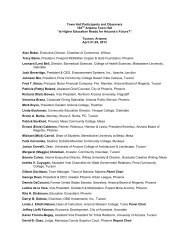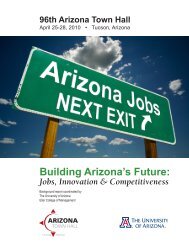Background Report - Arizona Town Hall
Background Report - Arizona Town Hall
Background Report - Arizona Town Hall
Create successful ePaper yourself
Turn your PDF publications into a flip-book with our unique Google optimized e-Paper software.
as a percentage of the state budget, but it is the first to go when economic times are tough. This is<br />
short sighted and overlooks the fact that arts and culture yield real economic and other returns that<br />
more than justify the investment.<br />
<strong>Arizona</strong> needs to develop more stable and diversified sources of funding for arts and culture.<br />
Government funding is critical to address geographic disparities, differences between rural and<br />
urban areas, and private sector preferences. Examples of how <strong>Arizona</strong> might achieve more stable<br />
and diversified funding of arts and culture include:<br />
<br />
<br />
oversee the allocation of funds to arts and culture institutions.<br />
<br />
arts and culture and identifying and supporting candidates for elected office who will<br />
champion arts and culture.<br />
<br />
arts and culture.<br />
<br />
arts and culture and pursue zoning improvements.<br />
Maximizing and Better Utilizing Available Resources<br />
The most powerful method for maximizing available resources is to build robust arts and culture<br />
networks to share information and coordinate efforts. These networks may consist of partnerships<br />
among the organizations themselves or umbrella organizations, such as arts councils formed to<br />
act as a resource for consolidation. The value of a network increases with each additional<br />
participant. Commonalities can be identified to increase efficiency. Organizations are filled with<br />
creative people who should be leading the nation in the development of innovative ways to finance<br />
their activities.<br />
Many arts and culture organizations share common functions, often not apparent to patrons, where<br />
consolidation would let them pursue efficiencies. Examples of these include accounting, human<br />
resources, insurance, list management, purchasing and other back-office operations. Networking<br />
and pooling of resources would allow each group to reduce its overall costs and provide valuable<br />
resources to employees. Where there is duplication and competition for funding resources,<br />
partnerships, alliances and mergers should be considered. Arts and culture organizations cling<br />
strongly to their individual identities and may find consolidation of some operations threatening.<br />
For this reason, the involvement of a third party, such as an arts council, may be warranted to<br />
facilitate consolidation. Mergers of organizations that have different missions, cultures and<br />
practices may be difficult to engineer and ultimately may not be successful.<br />
The business community is another potential resource for improving efficiencies. Businesses can<br />
donate office supplies and equipment, the time of their executives and skilled employees, office<br />
016 | <strong>Report</strong> of Findings and Recommendations




